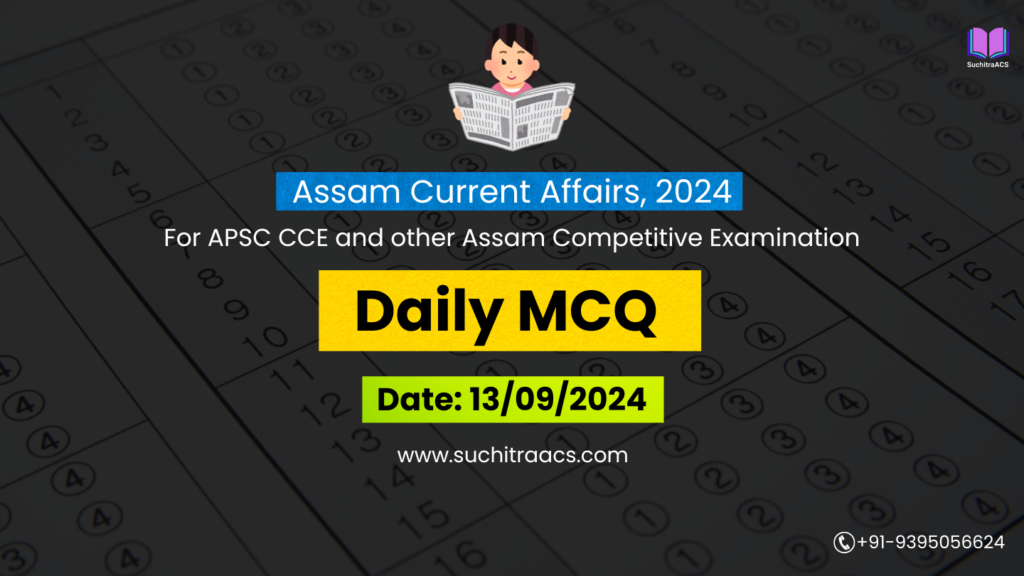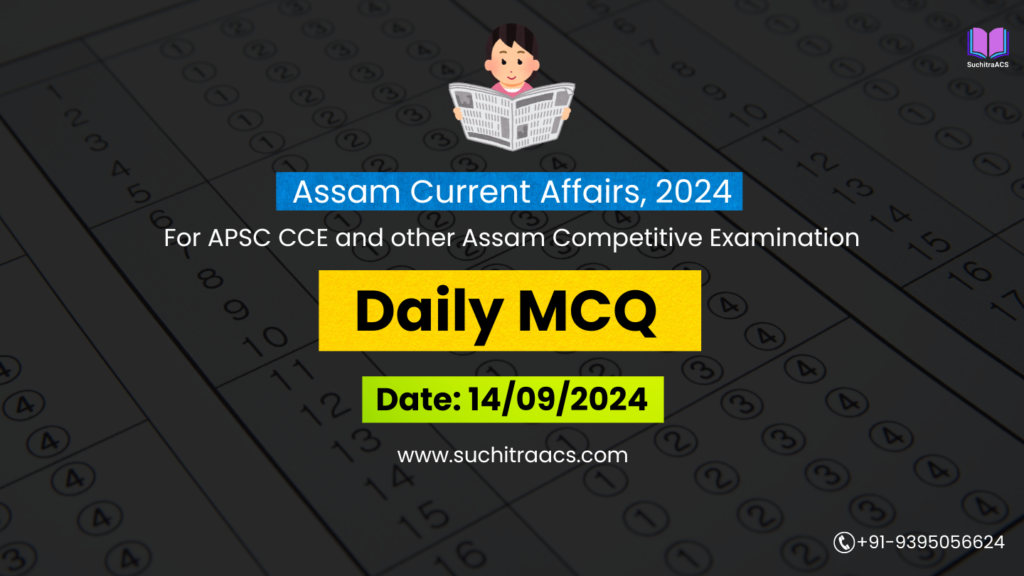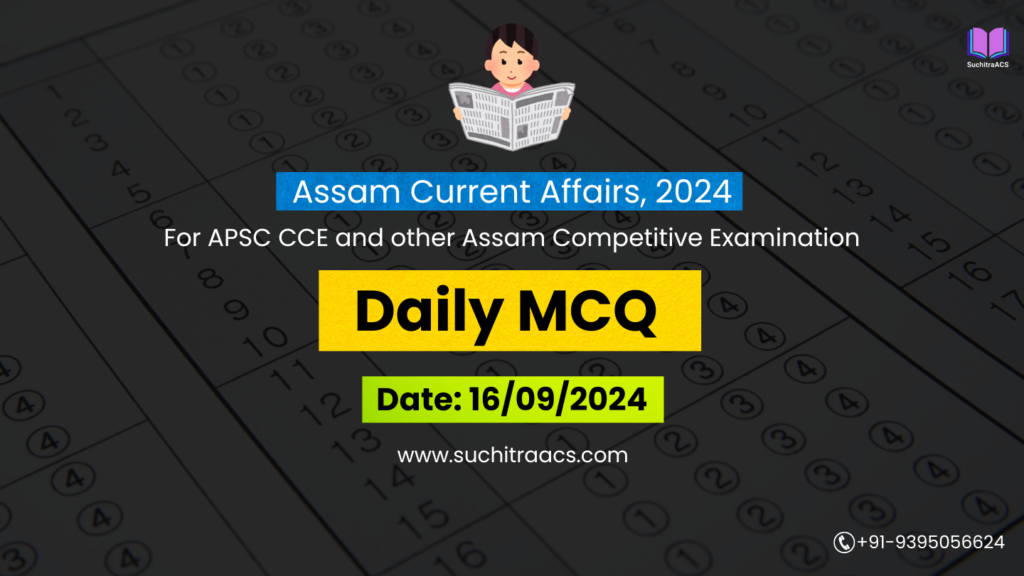APSC MCQs / APSC Prelims Practice Questions based on Assam Tribune (Daily) – 24/01/2025
For APSC CCE and other Assam Competitive examinations aspirants, practicing Daily MCQs is vital. This blog covers most important Prelims questions from the Assam Tribune today (24-01-2025). These issues are key for both APSC Prelims syllabus, offering insights into the important topics of current affairs.
APSC MCQs / APSC Prelims Practice Questions (Date: 24/01/2025)
Topic 1: Lag in Jal Jeevan Mission Implementation in Assam
Q1. With reference to the Jal Jeevan Mission (JJM), consider the following statements:
- JJM aims to provide functional household tap connections (FHTCs) to all rural households in India.
- Assam has achieved 100% coverage under JJM.
- The mission focuses solely on providing water supply and does not include water quality monitoring.
Which of the statements given above is/are correct?
a) 1 only
b) 1 and 3 only
c) 2 only
d) 1, 2, and 3
Answer: a) 1 only
Explanation:
- Statement 1: Correct. JJM aims to ensure FHTCs to all rural households by 2024.
- Statement 2: Incorrect. Assam’s coverage is at 81.32%, with several villages yet to be covered.
- Statement 3: Incorrect. JJM includes water quality monitoring and management as part of its mandate.
Q2. The presence of arsenic and fluoride in groundwater in some regions of India is primarily linked to:
a) Overuse of chemical fertilizers in agriculture
b) Natural geological formations
c) Industrial effluents
d) Deforestation
Answer: b) Natural geological formations
Explanation:
Arsenic and fluoride contamination in groundwater often originates from natural geological processes, especially in states like Assam, Bihar, and West Bengal.
Topic 2: Kamakhya Debutter Board Case: Misappropriation of Funds
Q3. With reference to the governance of religious institutions in India, consider the following statements:
- The Kamakhya Debutter Board is responsible for managing the administration of the Kamakhya Temple.
- The Comptroller and Auditor General (CAG) audits all religious institutions in India.
- Public Interest Litigation (PIL) can be filed to ensure transparency in the governance of temples.
Which of the statements given above is/are correct?
a) 1 and 2 only
b) 1 and 3 only
c) 2 and 3 only
d) 1, 2, and 3
Answer: b) 1 and 3 only
Explanation:
- Statement 1: Correct. The Kamakhya Debutter Board oversees the temple’s management.
- Statement 2: Incorrect. The CAG does not audit all religious institutions; temple boards are often governed by state laws.
- Statement 3: Correct. PILs can be filed to address governance and transparency issues in temple management.
Topic 3: Healthcare in Tea Gardens: Ayushman Arogya Mandirs
Q4. Consider the following statements about Ayushman Arogya Mandirs:
- They are healthcare facilities set up exclusively for tea garden workers in Assam.
- These facilities are integrated with the Ayushman Bharat – Pradhan Mantri Jan Arogya Yojana (AB-PMJAY).
- They focus only on curative care and do not include preventive health services.
Which of the statements given above is/are correct?
a) 1 and 2 only
b) 2 only
c) 1 and 3 only
d) 1, 2, and 3
Answer: a) 1 and 2 only
Explanation:
- Statement 1: Correct. Ayushman Arogya Mandirs specifically cater to tea garden workers and their families.
- Statement 2: Correct. These facilities are integrated with AB-PMJAY, providing free secondary and tertiary healthcare.
- Statement 3: Incorrect. They also include preventive care, such as antenatal services and immunization.
Q5. Tea garden workers in Assam face higher health risks due to:
- Malnutrition and poor living conditions
- Lack of access to clean drinking water and sanitation
- Occupational exposure to chemicals and poor ergonomics
Select the correct answer using the codes given below:
a) 1 and 2 only
b) 2 and 3 only
c) 1 and 3 only
d) 1, 2, and 3
Answer: d) 1, 2, and 3
Explanation:
All three factors contribute to the poor health outcomes among tea garden workers in Assam, necessitating targeted healthcare interventions.
Topic 4: Focus on Technology in Northeast Development
Q6. Which of the following initiatives aim to improve digital infrastructure in the Northeast region?
- BharatNet Project
- Digital Northeast Vision 2022
- National Bamboo Mission
Select the correct answer using the codes given below:
a) 1 and 2 only
b) 2 and 3 only
c) 1 and 3 only
d) 1, 2, and 3
Answer: a) 1 and 2 only
Explanation:
- BharatNet Project and Digital Northeast Vision 2022 focus on enhancing digital connectivity in the region.
- National Bamboo Mission focuses on bamboo-based livelihood and industry development, not digital infrastructure.
Q7. Consider the following technologies:
- Telemedicine
- Geographic Information System (GIS)
- Blockchain
Which of the above are being used to address challenges in the Northeast region of India?
a) 1 only
b) 1 and 2 only
c) 2 and 3 only
d) 1, 2, and 3
Answer: d) 1, 2, and 3
Explanation:
Blockchain is being explored for transparent governance and supply chain management in agriculture and MSMEs.
Telemedicine is being used to provide healthcare services in remote areas.
GIS is widely used in agriculture, disaster management, and urban planning.
 APSC Prelims Crash Course, 2025
APSC Prelims Crash Course, 2025
at most affordable rate in Assam!

🔔 Join Our WhatsApp Study Group!
For exclusive access to premium quality content, including study materials, current affairs, MCQs, and model answers for APSC CCE and other Assam competitive exams.
Click here to join: SuchitraACS Study WhatsApp Group
📚 Want to know more about SuchitraACS’s most affordable courses?
Click here to know more: SuchitraACS Courses for APSC CCE and Assam Competitive Examinations




